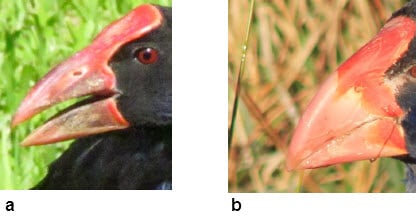Can you tell the difference between the endangered takahē and the common pūkeko? Do you know what takahē use their wings for? Or how much they poo?
Test your knowledge with this ultimate takahē quiz.
- Whose beak is this? Decide which one is a takahē and which is a pūkeko imposter.

Images: Anne Thornley (a), Helen Dodson (b) - After being thought extinct for 50 years, what year were takahē famously rediscovered by Geoffrey Orbell and his party?
- 1958
- 1948
- 1944
- 1942
- True or false – Takahē parents take shifts sitting on the nest.
- Which introduced mammals pose a threat to wild takahē populations?
- Deer
- Stoats
- Cats
- All of the above
- Whose legs are these? Decide which one is a takahē and which is a pūkeko imposter.

Images: DOC - Takahē’s native habitat is:
- Rocky alpine terrain
- Native grasslands
- Coastal dunes
- Swamps
- Look at these cute chicks. Which one is a takahē and which one is a pūkeko?

Images: DOC (a), Stewart Baird (b) - Which of these is not a place where you can go to see a takahē currently?
- Orokonui EcoSanctuary
- ZEALANDIA
- Tiritiri Matangi Island
- Rakiura/Stewart Island
- What do takahē use their wings for?
- Flying, duh
- Nothing – they’re a leftover evolutionary feature
- Insulation
- Display during courtship
- Why do takahē have such big beaks?
- To crush hard seed shells
- To pull out deep-rooted tussock
- To show off to potential mates
- To help them regulate their body heat
- Due to their fibrous diet how much do takahē poo per day?
- 3 to 5 metres
- 7 to 9 metres
- 1 to 2 metres
- 4 to 7 metres
- Whose feathers are these? Decide which one is a takahē and which is a pūkeko imposter.

Images: DOC
Scroll down to get the answers...
Here are the answers
- a: Pūkeko, b: takahē
- b. 1948. Takahē were thought to be extinct for over 50 years.
- True. Takahē pairs on average lay two eggs.
- d. Stoats are the main predators of takahē. In 2007 there was a stoat plague that halved the takahē population in the Murchison Mountains. Deer also compete with takahē for food.
- a: Takahē, b: pūkeko
- b. Takahē were historically found throughout the native grassland environments of the South Island. Although the last population was found in the alpine tussocks of the Murchison Mountains, takahē have higher survival rates in less harsher grassland environments.
- a. Takahē, b. pūkeko
- d. Rakiura/Stewart Island does not have takahē, but many other places do!
- d. Takahē use their wings for courtship displays, and also as a sign of aggression
- b. Takahē need strong beaks to pull out their favourite food: tussock tillers and seeds.
- b. An impressive 7 to 9 metres.
- a: Pūkeko, b: takahē